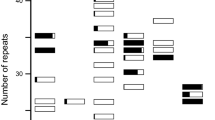Abstract
Mimosa scabrella Bentham, popularly known as “bracatinga” in Brazil, is a very important multipurpose tree especially in the southern region of the country, where it occurs naturally in plant associations called “bracatingais”. The species is presently in danger of losing genetic variability as it normally occurs in regions subjected to intense urbanization, industrialization, agriculture and cattle raising. Aiming at broadening the knowledge about the species we have investigated cytogenetic characteristics and genetic diversity among natural populations. The results show that all populations are tetraploid (2n = 4× = 52) and that there is a high genetic diversity among the populations. There is still time to avoid genetic erosion of M. scabrella if the areas where the species occurs are protected.





Similar content being viewed by others
References
AgroForestryTree Database (2012) World Agroforestry Centre. Available at www.worldagroforestry.org. Accessed on 23 June 2012
Barneby RC (1991) Sensitivae censitae. A description of the genus Mimosa Linnaeus (Mimosaceae) in the New World. Mem N Y Bot Gard 65:1–835
Bentham G (1876) Leguminosae III. Mimoseae. In: Martius CFP, Eichler AG (eds) Flora Brasiliensis, vol 5. London, pp 257–504
Bessega C, Hopp HE, Fortunato RH (2008) Toward a phylogeny of Mimosa (Leguminosae, Mimosoideae): a preliminary analysis of southern South American species based on chloroplast DNA sequence. Ann Mo Bot Gard 95:567–569
Bortolini F, Dall’Agnol M, Schifino-Wittmann MT (2006) Molecular characterization of the USDA white clover (Trifolium repens L.) core collection by RAPD markers. Genet Resour Crop Evol 53:1601–1610
Caramori PH, Androcioli Filho A, Leal AC (1996) Coffee shade with Mimosa scabrella Benth. for frost protection in southern Brazil. Agrofor Syst 33:205–214
Dahmer N, Simon MF, Schifino-Wittmann MT, Hughes CE, Miotto STS, Giuliani JC (2011) Chromosome numbers in the genus Mimosa L.: cytotaxonomic and evolutionary implications. Plant Syst Evol 291:211–220
Escudero A, Iriondo JM, Torres ME (2003) Spatial analysis of genetic diversity as a tool for plant conservation. Biol Conserv 113:351–365
Hamrick JL (2004) Response of forest trees to global environmental changes. Forest Ecol Manag 197:323–335
Huziwara Y (1962) Karyotype analysis in some genera of Compositae. VIII. Further studies on the chromosomes of Asteraceae. Am J Bot 49:116–119
Lacerda DR, Acedo MDP, Lemos JP, Lovato MB (2001) Genetic diversity and structure of natural populations of Plathymenia reticulata (Mimosoideae), a tropical tree from the Brazilian Cerrado. Mol Ecol 10:1143–1152
Ledig FT (1992) Human impacts on genetic diversity in forest ecosystems. Oikos 63:87–108
Levan A, Fredga K, Sandberg AA (1964) Nomenclature for centromeric position on chromosomes. Hereditas 52:201–219
Lewis G, Schrire B, Mackinder B, Lock M (2005) Legumes of the world. Royal Botanic Garden Kew, UK
Lorenzi H (1992) Árvores brasileiras I: manual de identificação e cultivo de plantas arbóreas nativas do Brasil. Instituto Plantarum Nova Odessa, Brazil
Lorenzi H (1998) Árvores brasileiras II: manual de identificação e cultivo de plantas arbóreas nativas do Brasil. Instituto Plantarum Nova Odessa, Brazil
Mantel N (1967) The detection of disease clustering and a generalizated regression approach. Cancer Res 27:209–220
Miller MP (2005) Alleles in space (AIS): computer software for the joint analysis of interindividual spatial and genetic information. J Hered 96:722–724
Morales M, Wulff AF, Fortunato RH, Poggio L (2011) Karyotype studies in Mimosa (Mimosoideae, Leguminosae) from Southern South America and ecological and taxonomic relationships. Caryologia 64:203–214
Pometti CL, Vilardi JC, Cialdella AM, Saidman BO (2010) Genetic diversity among the six varieties of Acacia caven (Leguminosae, Mimosoideae) evaluated at the molecular and phenotypic levels. Plant Syst Evol 284:187–199
Reeves A (2001) MicroMeasure: a new computer program for the collection and analysis of cytogenetic data. Genome 44:359–443
Rohlf FJ (2001) Ntsys PC numerical taxonomy and multivariate analysis system: version 2.1. Exeter Software, New York
Roy A, Frascaria N, Mackay J, Bousquet J (1992) Segregation random amplified polymorphic DNAs (RAPDs) in Betula alleghaniensis. Theor Appl Genet 85:173–180
Seijo G (1993) Números cromosómicos en especies argentinas del género Mimosa (Leguminosae). Bol Soc Arg Bot 29:219–223
Seijo G, Fernández A (2001) Chromosome numbers of some southernmost species of Mimosa L. (Leguminosae). Cytologia 66:19–23
Simon MF, Proença C (2000) Phytogeographic patterns of Mimosa (Mimosoideae, Leguminosae) in the Cerrado biome of Brazil: an indicator genus of high-altitude centers of endemism? Biol Conserv 96:279–296
Simon MF, Grether R, Queiroz LP, Särkinen TE, Dutra VF, Hughes CE (2011) The evolutionary history of Mimosa (Leguminosae): toward a phylogeny of the sensitive plants. Am J Bot 98(7):1201–1221
Sobierajski GR, Kageyama PY, Sebbenn AM (2006) Estimates of genetic parameters in Mimosa scabrella populations by random and mixed reproduction models. Crop Breed Appl Biotechnol 6:47–54
Sokal RR, Oden NL (1978) Spatial autocorrelation analysis in biology 1. Methodol Biol J Linn Soc 10:199–228
Somarriba E, Kass D (2001) Estimates of above-ground biomass and nutrient accumulation in Mimosa scabrella fallows in southern Brazil. Agrofor Syst 51:77–84
Stebbins GL (1971) Chromosomal variation in higher plants. Edward Arnold, London
Tian B, Yang HQ, Wong KM, Liu AZ, Ruan AY (2011) ISSR analysis shows low genetic diversity versus high genetic differentiation for giant bamboo, Dendrocalamus giganteus (Poaceae: Bambusoideae), in China populations. Genet Resour Crop Evol 59:901–908
Acknowledgments
To Conselho Nacional de Desenvolvimento Científico e Tecnológico (CNPq), Brazil, for financial support. To Dr. Miguel Dall′Agnol, Departamento de Plantas Forrageiras e Agrometeorologia, for allowing the utilization of his laboratory facilities.
Author information
Authors and Affiliations
Corresponding author
Rights and permissions
About this article
Cite this article
Dahmer, N., Schifino-Wittmann, M.T., Guerra, D. et al. “Bracatinga” (Mimosa scabrella Bentham), a multipurpose tree growing in Southern Brazil: chromosome number and genetic variation. Genet Resour Crop Evol 60, 377–383 (2013). https://doi.org/10.1007/s10722-012-9931-6
Received:
Accepted:
Published:
Issue Date:
DOI: https://doi.org/10.1007/s10722-012-9931-6




